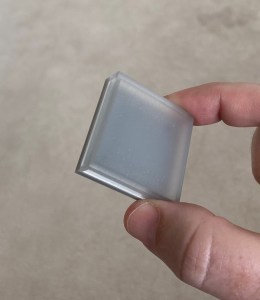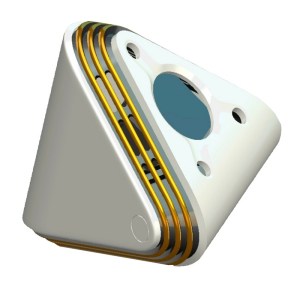In a fight to slow the global spread of Covid-19, which has already claimed more than one-million lives worldwide, researchers continue to look for ways to slow or kill the virus. Startup NS Nanotech said it has developed a solid-state far-UVC chip that kills the coronavirus and other airborne pathogens without posing any harm to people.
It’s commonly known that germicidal UV-C light, typically at a wavelength of 254 nanometers (nm), is highly effective at killing bacteria and viruses, and is used to disinfect all kinds of equipment, particularly medical devices. However, it is a health hazard for humans, potentially causing harm to eyes and skin, including skin cancer.
“The current generation of lamps that emit longer UV-C waves of up to 280 nm have been used for decades to sanitize air and surfaces in hospitals and other large facilities,” said Seth Coe-Sullivan, NS Nanotech’s co-founder and CEO. “But their use cases are limited because UV-C light has the potential to cause skin cancer, cataracts or other ailments in humans. They are most often used only in enclosed HVAC air filters, with robots, or other environments where the harmful longer-wavelength light won’t come into contact with people.”
Several recent research studies have shown that far-UVC light, at a wavelength of between 207 to 222 nm, can kill airborne viruses without harming human skin. This include Hiroshima University researchers that have claimed the first research study to show that using UV-C light with a wavelength of 222 nm is safe to use around humans and effectively kills SARS-CoV-2.
The challenge was developing an efficient and cost-effective solid-state far-UVC light by improving the fabrication process and efficiency of the light emitting materials.

NS Nanotech’s solid-state semiconductor device emits far-UVC disinfecting light.
Thanks to a breakthrough in semiconductor design, using its patented nitride semiconductor and nano-LED technologies, NS Nanotech has developed the first solid-state emissive material to produce invisible shortwave far-UVC light that can kill 99.9% of SARS-CoV-2 virus and other airborne pathogens without posing any health risks to humans.
The company claims the new nitride semiconductor chips are the first solid-state devices to emit far-UVC light at wavelengths ranging from 200-to-222 nanometers.
“We are providing a new first line of defense against airborne pathogens,” said Coe-Sullivan. “Far-UVC light can deactivate a virus before it reaches you. Your face mask, which only traps the virus before you breathe it in, will be your second line of defense. Vaccines, if and when they become available, will be a third line of defense that neutralizes the virus only after you have become infected.”
Initial samples of the solid-state far-UVC chip will be available to OEMs before the end of the year with a fast ramp up to volume production in 2021.

Concept rendering of NS Nanotech’s portable air purifier using the far-UVC solid-state light
source.
The company also is fast-tracking a consumer personal UV air purifier the size of a coffee mug that deactivates airborne pathogens, using its far-UVC chips. The company expects the air purifier to be available in 2021. It can be used virtually anywhere, including at home, at work, and at school.
The 222-nm far-UVC light is able to deactivate germs without needing it to pass through a system and that’s quite unique, said Coe-Sullivan. The device looks more like a fan or air purifier that you can put on your desk and cleans the air before you breathe it.
The technology
The chips are built on a new nitride semiconductor technology that is based on exclusively licensed patent portfolios from McGill University and the University of Michigan. The new patents dramatically improve the fabrication process and efficiency of nanoscale light emitting materials, which opened the door for the development of a solid-state far-UVC light. These technologies provide light in the invisible UV spectrum for far-UVC disinfection and in the visible red-green-blue (RGB) spectrum for LED display applications.
The solid-state far-UVC chip leverages these patented technologies, primarily invented by co-founder Zetian Mi, who also is a professor at the University of Michigan.
Mi has been exploring and inventing better ways to grow nitride semiconductors, said Coe-Sullivan. Indium gallium nitride (InGaN) is a phenomenal material that makes up every single blue LED, but one of the problems with InGaN is that if you try to make it green, the efficiency falls off by a factor of four, and there is no example of red, he added.
By nanostructuring the InGaN semiconductor material, Mi has figured out how to grow defect-free crystals for LEDs, which translates into efficient green and red InGaN devices, which is unique, said Coe-Sullivan. “He can also put it within a photonic band gap, in a photonic crystal, by arranging the nanostructures just right. The result is this wonderful ensemble effect where all of the light is extremely monochrome, extremely single color, and extremely directional.”
So how does this translate into the invisible UV spectrum?
“By having that nanostructured ability in the visible light spectrum it lets us get higher and higher indium doping to turn it from blue to green to red while maintaining crystal quality and maintaining efficiency as a result,” Coe-Sullivan explained. “If you dope aluminum into gallium nitride, you make aluminum gallium nitride (AlGaN), a well-known semiconductor material, and this is how you move it from the blue to the UV wavelength.”
“By employing these same tricks that we’re doing in the visible light by nanostructuring the AlGaN material and then by arranging it into a photonic band gap, we can get higher aluminum doping and push that wavelength lower and lower by increasing the aluminum ratios,” explained Coe-Sullivan. “So now you can have AlGaN emitting in the general UV-C range but also now in the far-UVC range and that is what’s very exciting now.”
UV-C LEDs based on the AlGaN material are available in the market today, said Coe-Sullivan, but they offer very poor performance, including in efficiency and lifetime.
Coe-Sullivan also noted that there are several UV-C lighting suppliers that have introduced far-UVC 222-nm lamps, but they are based on an earlier generation of technology using krypton chlorine excimer bulbs that are large, fragile, and expensive. They are also too hot to touch and require filters to block the longer UV-C wavelengths, which add substantial cost to the lamps, he said.
The solid-state semiconductor emitter design eliminates those problems, along with running cooler thanks to the solid-state design, he said. In addition, the smaller form factor (38-mm square) allows the chip to be designed into a wide range of products.
Coe-Sullivan has a Ph.D. in electrical engineering from the Massachusetts Institute of Technology (MIT). He has a track record of success in solid-state technology, selling his quantum-dot display company, QD Vision, to Samsung in 2016. That technology is now incorporated into millions of Samsung TVs.
Advertisement





